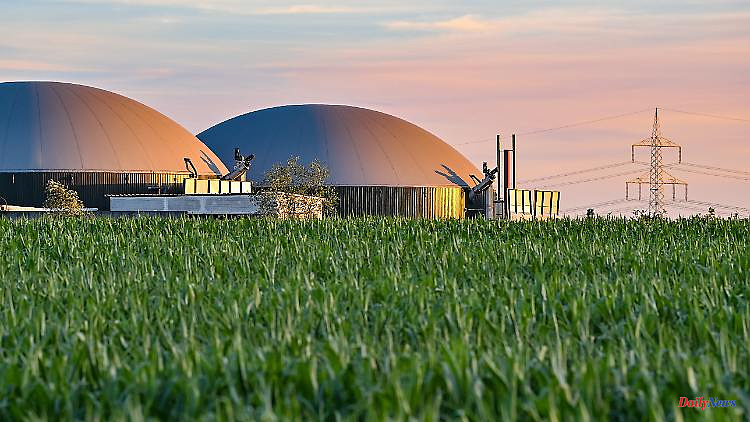Germany is feverishly looking for alternatives to Russian natural gas. Producers of renewable biogas want to fill the gap. The federal government wants to lift its production cap. But biogas plants can hardly produce any more energy in the short term. And there is one more problem.
Corn, liquid manure, kitchen waste or plant residues are put into a container, everything is fermented with the help of bacteria and biogas is then produced from it. Alongside sun, water and wind, biogas is one of the regenerative energy sources and can be produced in a biogas plant. There are currently around 9,200 of them in Germany.
The plants may only produce a certain amount of biogas. The Renewable Energy Sources Act caps the amount of gas produced - and also the expansion of biogas plants. But the federal government wants to lift this cap.
The limit was introduced so that biogas plants can step in when the sun and wind are not producing enough energy. In addition, bioenergy can be stored. "People wanted to use this strength when buying electricity that is so expensive. They said it would be produced in the hours when demand was particularly high. In addition, an extra payment, the flexibility bonus, was introduced," explains Jan Seven, Head of Department for Renewable Energies at the Federal Environment Agency (UBA) in the ntv podcast "Learned again". "The bottom line was that the hope was that fewer renewable raw materials would be needed, because such a system would no longer run 6,000 to 7,000 hours a year, but maybe only 2,500 or 3,000 hours."
The main products of biogas plants are electricity and heat. A combined heat and power plant is powered by the biogas. It works in a similar way to a car: the gas is burned to drive a motor that generates electricity. The waste heat from the engine can be used for heating or hot water - but so far only to a very small extent.
Around 940 terawatt hours (TWh) of gas are consumed in Germany every year. Just one percent of this is biogas: around ten TWh are fed into the gas grid. In the case of power generation, the share is only slightly higher, at around five percent and thus behind wind power and photovoltaics. The biogas plants in Germany supply around 9 million households with electricity.
However, the industry is convinced that even more is possible in biogas production - if the federal government lifts this cap as announced. In the short term, 20 percent more electricity and gas could be generated from biogas, writes the capital's bioenergy office in a position paper. If you use more raw materials or those that have a high energy content, such as corn. The Biogas Association believes that five percent of Russian gas imports can be replaced immediately. The state would have to pay more subsidies for this than is stipulated in the Renewable Energy Sources Act. According to the association, biogas production could even be doubled within five to ten years.
Jan Seven doesn't expect that. "For economic reasons, it is not feasible and also not justifiable to continue to promote biogas to the same extent or to follow certain conversion scenarios." Compared to other renewable energies, biogas is by far the most expensive form of energy. Also because food, which is largely used in biogas plants, has become more expensive. "That's why we don't really see any cost reductions at all with biogas, which we saw massively with solar power and wind last year."
In biogas plants, not only waste such as organic waste, green waste or animal manure is recycled. Above all, specially cultivated plants such as corn, wheat, sugar beets or rapeseed migrate in. Maize accounts for the largest share: three quarters of the biogas is obtained from it. Because corn contains the most methane.
These energy crops occupy 15 percent of German arable land. A total of 1.5 million hectares, which are actually urgently needed to grow food and fodder there, says Jan Seven. "No food grows on these areas, there is no feed for the animals that we keep in large numbers. We import the feed from Brazil. We have direct competition between the plate and the fermenter." In a fermenter in a biogas plant, the raw materials are heated and decomposed so that biogas can be produced.
The large-scale production of biogas not only wastes valuable food, there is also a very practical problem: many biogas plants are not connected to the gas network. The connection is often not possible because the gas network is too far away and the systems are too small, says Jan Seven. Transport by tanker is expensive. "They were never designed to feed anything into the gas network." The reason for this was the promotion of electricity from biogas through the Renewable Energy Sources Act.
Biogas cannot replace Russian gas in the short term. "If it is suggested that this biogas could be used one-to-one instead of gas from the gas pipeline, then that is not true."
Only 2.5 percent, 219 of the approximately 9,200 biogas plants in Germany, can feed gas into the gas network. For this to work, however, the biogas must first be processed into biomethane. Because biogas consists of very different substances: Around 50 to 75 percent is methane, the rest is mainly carbon dioxide, i.e. CO2. The CO2 must be removed. Only when this has happened and the biogas contains as much methane as natural gas can it be fed into the gas grid and used as biomethane.
The biogas plants that produce gas are very large and, according to Seven, provide ten percent of the biogas. "They need a lot of raw materials, which have to be carted in from a very wide area around the plant. In order to minimize the transport distance, we then have large concentrations of corn fields around such plants."
The expert for renewable energies therefore advocates using the cultivated areas for photovoltaic systems or wind turbines instead. On average, solar systems could generate 40 times more electricity per year than biomass, such as corn, in the same area. This is in an internal paper from the UBA. Biogas is therefore considered to be significantly less environmentally friendly than other renewable energies.
Such systems only really make sense if you use liquid manure. Because then you save methane emissions and make something useful out of it, says the energy expert. 30 percent of liquid manure is now used to generate energy. However, less energy can be obtained from liquid manure than, for example, from maize.
The Federal Environment Agency writes in a study that it is possible to use more liquid manure - but the framework conditions would have to change for this to happen. "Using the remaining 70 percent is a noble goal. It's not that easy," estimates Jan Seven. Fermenting manure is less energy production than a "form of climate-friendly waste disposal."
The biogas producers want to replace Russian gas with bioenergy in the short term. But that is expensive and bad for the environment. Because it means using more extra-cultivated plants such as corn for energy production.












